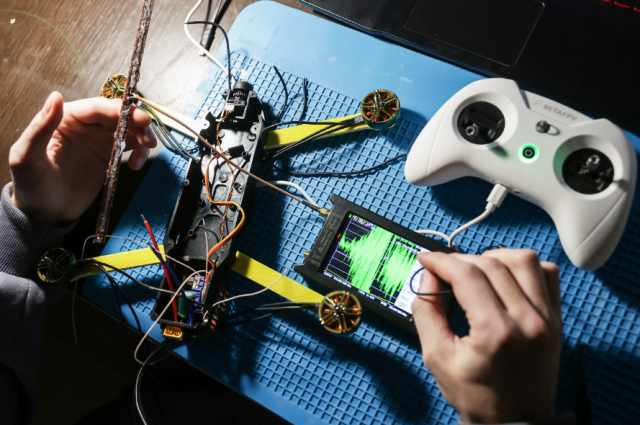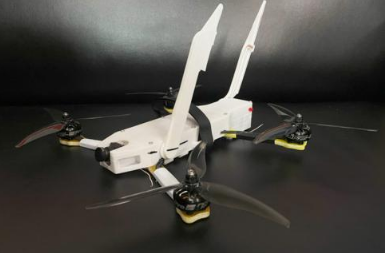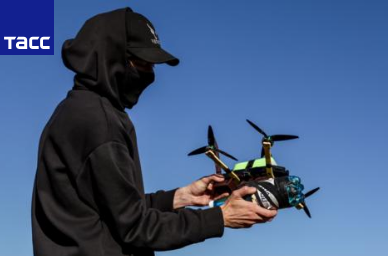The special military operation in Ukraine has lowered the entry threshold for new players in the defense market. Niches were formed, which began to be occupied by small initiative groups of developers, often without even a legal entity — only an idea and a willingness to instantly adapt it to the demands of the army. The "new generation of entrepreneurs" was also noted by the top military leadership. TASS analyzes the phenomenon of Russian military startups using the example of the FPV drone team's path with the sonorous name "Ghoul".
The FPV drone "Ghoul" was developed in the Sverdlovsk region for strikes against the enemy deep in the front, including to prevent the supply of ammunition and the destruction of armored vehicles in closed positions. In the process of combat use during the SVO, he proved himself positively: he destroyed boats with troops on the Dnieper, fortifications, dugouts and enemy strongholds. To date, it is used in all areas of a special military operation.
The FPV drone "Ghoul" was developed in the Sverdlovsk region for strikes against the enemy deep in the front, including to prevent the supply of ammunition and the destruction of armored vehicles in closed positions. In the process of combat use during the SVO, he proved himself positively: he destroyed boats with troops on the Dnieper, fortifications, dugouts and enemy strongholds. To date, it is used in all areas of a special military operation.
"Turned on the war"
The term "startup" is more commonly seen next to names such as Apple, Amazon, SpaceX and Uber. The stories of these and other Western companies, which created innovative solutions for the IT market "in garages" and rose to the world level, set the trends and framework for such a business development format. Common recognizable features: novelty, rapid growth and scalability, attracting investments from third-party sources. With the beginning of the SVO in Russia, initiative groups began working on these patterns, which sought to apply the accumulated competencies for the benefit of the country's military-industrial complex.
We get to know Vladimir, the leader of the development team of the "Ghoul" FPV drone, in the Telegram messenger, which has become the main communication channel for military equipment developers, volunteers and military personnel in recent years. After a short greeting, he briefly interrupts the connection, confirming my identity with a mutual acquaintance. This is the first (but not the last) difference between Russian military startups from classic ones — a balance between publicity, which is necessary to raise funds for development, and confidentiality dictated by security measures. In this regard, the names of some of the characters in this material have been changed.
Since 2017, my interlocutor has been leading a group on VKontakte "Turned at war" (more than 200 thousand subscribers), which went to the Telegram channel (more than 700 thousand subscribers). He had an interest in the topic, knowledge about potential niches and problems that need to be solved even before his time.
"The idea to make a drone with my friends, who appeared thanks to the "Turned", was back in 2020. We studied the whole topic, looking for options for the supply of components. That year, in the Karabakh conflict, everyone saw the Turkish Bayraktar drones, and sensible people understood that something needed to be done, Russia needed to accelerate in this direction," he says.
The Bradley Level Problem
A sharp impetus from thoughts to actions at the end of 2022 was the announcement of supplies of heavy military armored vehicles from NATO countries to Ukraine: Leopard tanks, Bradley infantry fighting vehicles, HMMVW vehicles, etc.
"We realized that we needed our own shock drone to burn them, and we thought about how to make it. First thought: there are a lot of RCG-3M hand grenades in warehouses, designed to destroy tanks and other armored vehicles. The solution followed from this — they attached one to the drone, flew into the equipment, into the armor, and — hooray," Vladimir describes the initial stage of the startup, when the problem and the method of its solution are formulated.
 |
| Drone assembly. |
| Source: Donat Sorokin/ TASS |
The team chose the FPV drone, an unmanned kamikaze aircraft, the pilot of which sees the image of the on-board camera "in the first person" through special glasses. Before the recent armed conflicts, 95% of the use of such equipment in the world was in sports competitions, 5% in cinematography. The concept of the future "Ghoul" was based on the desire to make the cheapest, but at the same time effective and safe product.
"There are those who don't bother," admits Vladimir. — It is clear that with the same drones, you can declare a collection, buy a frame, beams, boards cheaply abroad, collect 20 of them per day, earning on the difference. How far will these drones fly? How safe is it to use them? In my opinion, the drone must have an ammunition cocking system and a fuse. "Foolproof" is just as necessary here as on any military equipment, so that the soldier does not get blown up by carelessness. At first, a lot of incompetent people came in who thought that they would quickly cut down money here. Fortunately, both they and their products have mostly been eliminated today."
People's Drone
Since the emergence of startups, the generally accepted principle of attracting the first investments in a project has been derived in the 3F formula: friends, family, founder. At the same time, crowdfunding has proven itself well in Russia (public attraction of money for the implementation of the project) — "family" and "friends" turned out to be unrelated people who actively responded to a request for support for domestic developments.
"I started fundraising at my "Turned on the War", it was supported by the repost of more than 10 major Telegram channels. The amounts began to come in a variety of ways, from 50 rubles and above. The money we spent on the preparation of the first 500 drones is 9 million rubles, all collected from donations. But after a couple of weeks, I added about 4 million of my own funds, as we realized that the Chinese batteries that we purchased were unstable in power, and turned to a local manufacturer from Yekaterinburg," says Vladimir.
So the drone, which by that time already bore the fabulous name "Ghoul", memorable from the first time, also received the title of "people's drone".
Vladimir
Head of the Ghoul project
The next stage of a startup after attracting investments is the development of a working prototype, the release of an alpha version of the product and testing of its shortcomings. The first drones assembled by the Ural team differed from the sports equipment to which they owe their origin in the presence of the already mentioned ammunition platoon system and fuse, as well as the fact that they were significantly cheaper.
 |
| The first version of the FPV drone "Ghoul". |
| Source: © Alexey Gavrelyuk/ TASS |
"Unlike sports, there is no need for a carbon frame for 5-10 thousand rubles. You have a case for 200, and yes, it will shatter when you fall, but for a disposable product flying one way, it doesn't matter. The case is for 200, the rays are for 100. Cheap, angry, but it works," says Vladimir.
The Ambassador is on the front line
Two team members went to the first combat missions to the Luhansk People's Republic (testing the alpha version of the product) from the developers. One of them did not know yet that after several such trips he would sign a volunteer contract and remain for six months to serve under the call sign Rudy in one of the units.
"I started teaching DJI Mavic at the very beginning of my career (a series of popular quadrocopters from a Chinese manufacturer — approx. TASS), taught to pilot, make drops, etc. Therefore, I had enough experience both in the design of the drone and in training — they all went into business. When we took the first batch to the LPR, in a month I trained the first group there — 7-8 people. My talents were appreciated, and after my visit with the third batch of Ghouls, I was, one might say, persuaded," he recalls.
Thanks to his decision, everyone won: the division received an experienced operator and a specialized engineer, and the team of the Ural FPV drone was the ambassador of its product on the line of combat contact, who regularly supplied them with point feedback. "When you deliver a drone in crates and leave, it's one thing, but when you have to walk several kilometers with this drone, it's completely different. "Ghoul" has changed from the first version by about 80%. For example, we printed the first cases using polymers, from which dentists make prostheses, but they turned out to be too fragile, and we switched to the technology of thermoplastics under pressure. They changed the shape of the antennas, the back of the hull, and reduced the windage of the base station so that it would not fold from the air," Rudy lists.
The possibility of operational testing of military equipment in combat conditions gave Russian military startups a head start in the industry that they would not have had at any other time. In a situation where it is necessary to constantly increase technical superiority over the enemy, who is also continuously adapting to new inputs, mobility and readiness to rebuild on the fly are most important. This is traditionally better achieved by flexible small and medium-sized businesses that are not bound by a number of regulations, under which the giants of the military-industrial complex have to work.
After edits are made to the prototype, the almost finished product must undergo beta testing. The training grounds of the Main Directorate of Innovative Developments (GUIR) of the Ministry of Defense of the Russian Federation became the platform for this stage of Russian military startups. "For FPV drones, for example, the key indicator is the ability to work "at the bottom" (near the ground itself — approx. TASS) at a distance of 10 km — to look for targets, spin, make turns without losing the signal. A high-quality and clear picture is also [needed]. We passed the testing at GUIR without any complaints, we were only asked to increase the payload to 4 kg. That's what our developers have done: now the Ghoul can carry thermobaric shells," Vladimir said.
Ural "kids"
The personnel policy of the manufacturers of the drone "Ghoul" from the beginning of the project to the present day is described by the succinct word "tightened". The first ones were "pulled up" from everywhere: from military training centers at universities, at courses of shooting and engineering training, FPV athletes.
"Since 2022, people have a great desire to engage in drones, it's like a new space or being involved in re-creating aviation. The formation of the industry from scratch. We recruited kids from all over the Urals, then a chain reaction began — the team began to grow. All are ideological, charged with results. Everyone is literally living a video with the successful use of our drone," explains Vladimir, the head of the project.
"Kids" is not just a friendly pat on the shoulder. The average age of an employee of the manufacturing company "Ghoul" is 25 years old. These are yesterday's university graduates, like, for example, Artyom, who was "pulled up" from medical courses. He acquired basic engineering skills at the local railway university.
"I was ready to work for free, to do at least something useful in the topic of FPV. One day the bell rang... I thought I would come to everything ready, but in the end I helped unload the tables, on which we then collected the "Ghouls". And then I looked back — and there are not so few of us anymore. And we all have the same views, we all speak the same language, we are all young. We are very [good], to be honest," says Artyom.
Each of the first set is a universal today — they can accept components, and sit on the assembly line, and do firmware, and prepare beginners.
Alexander
member of the Ghoul project team
The guys responsible for the development are even younger — on average 22 years old, students. They have already stopped paying attention to the age of the 20-year—old namesake of the project leader Volodya - youth is so overlapped by innate talent and knowledge in the field of aviation, and not only unmanned. The young guy confidently conducts piloting classes with the visiting commandos. "It's just that in the first lesson, without introducing himself, he shows them in class what he can do, and then they pray to him themselves and carry him in their arms," says team leader Vladimir.
He brought his young talent to the project and his friends from the military training center at one of the Ural universities. "We are mainly working on modernization. For example, we are improving the antennas so that the signal gets further. The video transmitter has developed its own. They worked on modules that hide the signal in order to bypass the electronic warfare system (EW) so that it was possible to receive and send a signal only from one side, our side, and in the case of interception, the enemy did not receive any information. In general, everything comes from feedback, the problem is reported from the front line, and we are solving it here," says Ivan.
According to the guys, in an endless race with the enemy's electronic warfare, the "Ghoul" is now ahead. Another task facing students from military training centers, who upon graduation must sign a contract with the Ministry of Defense of the Russian Federation, is to establish a personnel pipeline. To replace the guys who have gained tremendous experience going to the troops, new promising newcomers come. The salary level in the Ural project is decent: employees at the assembly receive from 60 thousand rubles and above, developers — from 120 thousand rubles.
Continue to create a new one
By the end of autumn 2023, the Ghoul had become the enemy's headache in all areas of the special military operation. He especially distinguished himself in the Dnieper region, where, after the appearance of Ural drones and the defeat of dozens of boats with troops, the latter banned any movement along the river during the daytime. Information about the Russian development appeared in the German media and Ukrainian Telegram channels, where the enemy called the drone "one of the cheapest." At the same time, the production continued to be located in the same room of the former printing house, on an area of 30 square meters, and was supported by the enthusiasm of 12 people. The looming issue of scaling rested on the need to expand the area and attract large orders, since, despite the increased interest in the "Ghoul", the business continued to work mainly "to zero" — this is not a rare story for Russian military startups, which prioritize military assistance rather than profit.
A suitable room was found at about the same time with the help from the state. The office of the plenipotentiary representative of the President of the Russian Federation in the Ural Federal District, Vladimir Yakushev, came to the developers of the "Ghoul" and after several meetings began to provide maximum support.
"When we moved into a new building, which is a multiple of the previous one, they closed the needs of the new furniture workshop in less than a week. Now this help is constant — we are in touch with the office of the plenipotentiary. With their support, we received a large order, which became an anchor and allowed us to invest in development," says Vladimir, the head of the Ghoul project.
According to him, production at full capacity, taking into account the new areas, will start working within about two months. The company is provided with orders. 60% is the anchor order, the rest is accounted for by direct orders from divisions and donations from Russians — this part remains charitable. The team has tripled, as has production — what used to be done in a month is now collected in a week.
Vladimir
Head of the Ghoul project
After scaling, a classic startup enters a maturity stage, and the founder has a choice: sell a successful business to a large investor and start something new, or develop into his own company. Russian military business saw both ways. Large companies of the country's defense industry are monitoring the latest developments, some, according to TASS interlocutors, even singled it out as a separate task or created working groups. Startups are invited to meetings and offered support, which sometimes ends in an agreement beneficial to both sides. There are other examples — the private company Lobaev Arms or the manufacturers of "Lancets" Zala Aero, which have grown from artisanal workshops into large modern companies with products unique to the market.
It is the latter that Vladimir calls when he talks about approximate benchmarks, but at the same time, the head of the Ghoul project does not plan further growth of its own capacities in the near future: "I'm thinking of using the capacities of larger defense industry enterprises in our country. That is, they will have the assembly, and we will have the quality control. We already have such offers and contacts. But, of course, we will not sell everything. I want to continue doing this, and not give up on half. So that the big players are engaged in scaling the product, and you just create something new."
United Military Editorial Board

